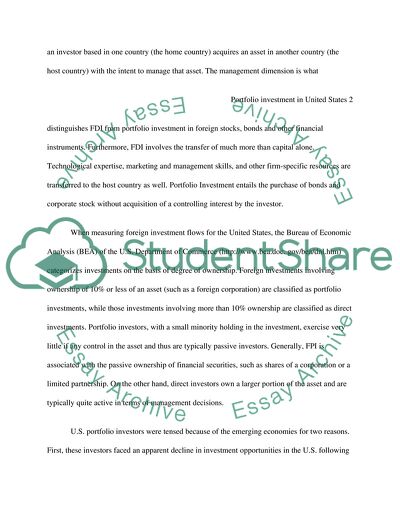
- Home
- Free Samples
- Premium Essays
- Editing Services
- Extra Tools
- Essay Writing Help
- About Us
- Studentshare
- Subjects
- Miscellaneous
- Finance
Finance - Essay Example

- Subject: Miscellaneous
- Type: Essay
- Level: Masters
- Pages: 4 (1000 words)
- Downloads: 0
- Author: jesse52
Extract of sample "Finance"
Such reformative steps taken by the governments resulted in growing cross-border investments. The increased mobility of capital which is the result of these changes has modified the theory of foreign investment. In light of such developments, this may be a particularly good time to take a closer look at a relatively underdeveloped subset of the theory of foreign portfolio investment, in United States. Foreign direct investment (FDI) and foreign portfolio investment (FPI) are traditionally treated as mutually exclusive.
As per the World Trade Organization (WTO) the distinction between FDI and FPI can be explained as follows. Foreign direct investment (FDI) occurs when an investor based in one country (the home country) acquires an asset in another country (the host country) with the intent to manage that asset. The management dimension is what distinguishes FDI from portfolio investment in foreign stocks, bonds and other financial instruments. Furthermore, FDI involves the transfer of much more than capital alone.
Technological expertise, marketing and management skills, and other firm-specific resources are transferred to the host country as well. Portfolio Investment entails the purchase of bonds and corporate stock without acquisition of a controlling interest by the investor. When measuring foreign investment flows for the United States, the Bureau of Economic Analysis (BEA) of the U.S. Department of Commerce (http://www.bea.doc. gov/bea/dnl.htm) categorizes investments on the basis of degree of ownership.
Foreign investments involving ownership of 10% or less of an asset (such as a foreign corporation) are classified as portfolio investments, while those investments involving more than 10% ownership are classified as direct investments. Portfolio investors, with a small minority holding in the investment, exercise very little if any
...Download file to see next pages Read More
- TERMS & CONDITIONS
- PRIVACY POLICY
- COOKIES POLICY